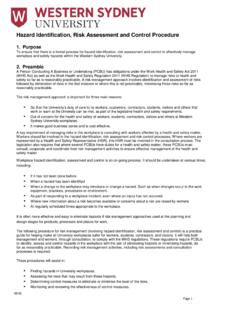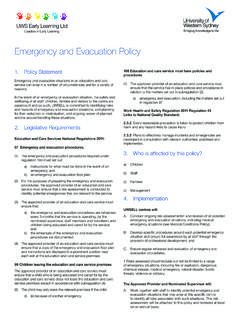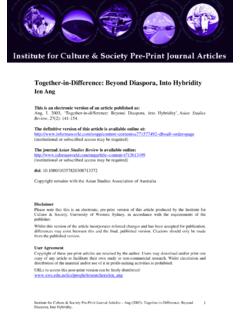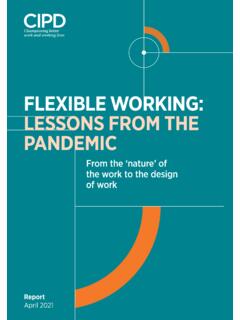Transcription of Social media and the wellbeing of children and young ...
1 Social media and the wellbeing of children and young people: A literature review Completed by: Dr Teresa Swist Dr Philippa Collin Ms Jane McCormack Associate Professor Amanda Third Institute for Culture and Society, University of Western Sydney for the Commissioner for children and young People, Western Australia July 2015. 1. Contents Social media and the wellbeing of children and young people: A literature review .. 1. Acknowledgements .. 3. Executive 4. Dimensions of Social media use .. 4. Impacts of Social media on wellbeing .. 5. Good practice and opportunities .. 6. Future needs .. 7. 10. Context .. 11. What is Social media ? How do children and young People Use it?
2 12. Technical dimension .. 13. Material 15. Social dimension .. 17. Motivational dimension .. 18. Critical Literacies for a Digital Age .. 21. Role of Social media for children and young People's 22. Approaches to the Study of the Effects of Social 23. Summary of Recent Literature Investigating the Impacts of Social media on the wellbeing of children and young 24. Mental and physical health .. 24. Identity and belonging .. 30. Formal and informal learning .. 35. Play and recreation .. 41. Consumer practices .. 45. 2. Civic and political engagement .. 52. Risk and safety .. 56. Family and intergenerational relationships .. 62. Key Findings .. 66. Early uptake with practices and motivations changing, intensifying and diversifying as children get older.
3 67. Interrelated dimensions of children and young people's Social media use .. 67. The impacts of Social media use on the wellbeing of children and young people . 68. Good practice and opportunities .. 70. Gaps and emerging research .. 71. Conclusion .. 72. References .. 73. Acknowledgements The authors are grateful to Ms Trish Heath (Commissioner for children and young People WA), Ms Anne Collier ( ) and Professor Ariadne Vromen (University of Sydney) for their advice on this review. Suggested citation: Swist, T., Collin, P., McCormack, J. & Third, A. (2015). Social media and the wellbeing of children and young people: A literature review. Perth, WA: Prepared for the Commissioner for children and young People, Western Australia.
4 3. Executive Summary children and young people's use of technology and Social media is evolving at a rapid pace, with implications for their wellbeing . To understand these changes there needs to be wider awareness of the types and use of Social media , impacts on wellbeing plus the range of good practice and opportunities available. Highlighting these can help parents, caregivers, service providers, educators, policymakers and other adults better identify and respond to the challenges and opportunities of children and young people's Social media use. To support effective policy, practice and service innovation, this review examined literature published since 2010 on children and young people's use of Social media and effects on their wellbeing .
5 From the age of five nearly all Australian children regularly access the internet and by the time they become teenagers are avid users of Social network services (SNS), online games and chat rooms, forums and instant messaging. As they increasingly go online via a mobile device or phone their access has become more personalised, frequent, and possible in a wide range of public and private spaces. Social media is a set of web applications that enable production, aggregation, sharing and remixing of content from multiple sources by mass, networked participants. They are giving rise to a rapidly evolving set of media practices and are increasingly embedded in other media modalities such as television, online games and search.
6 Consequently, Social media is becoming a common feature of children and young people's everyday lives. However, Social media are diverse and their effects on the wellbeing of children and young people are an emerging focus for research, policy and service delivery. Dimensions of Social media use This report identified four key dimensions that influence children and young people's Social media use: i) Technical dimension: hardware, software, connectivity and devices that enable Social media practices. ii) Material dimension: text, images and interactions that are produced and made visible on digital platforms and devices. iii) Social dimension: with whom and how children and young people interact via Social media , which can promote and enhance interpersonal connections at peer, family, local and global scales.
7 4. iv) Motivational dimension: values and drivers of children and young people's Social media use expressed in the different ways they approach and utilise Social media . children and young people's Social contexts, along with their desires to maintain relationships, express themselves to diverse audiences, and discover new information and ideas, profoundly shape their Social media engagement. Impacts of Social media on wellbeing The review identified eight key domains of Social media 's impact on children and young people: physical and mental health; identity and belonging; formal and informal learning; play and recreation; consumer practices; civic and political engagement; risk and safety; and, family and intergenerational relationships.
8 Among other findings, the review has identified that positive and negative impacts are contextual and that Social media : Promote positive norms about health and wellbeing and enhances health promotion initiatives. The range of content and culture of Social media provides low level exposure to a range of risks. However, experiencing some level or risk is necessary to build resilience online and offline. The rapidly increasing volume of information available online also opens up new questions about the sources and accuracy of information in the digital age. Foster identity formation, community-building and creativity. Across these positive developmental processes, children and young people can also experience upsetting and potentially harmful content and practices which can have serious effects on their wellbeing .
9 Support the self-directed learning and aspirations of marginalised young people and extend formal and informal knowledge networks and Social support for young people generally. However, poor integration of Social media in formal and informal learning networks can reinforce Social exclusion. Provide new leisure, play and recreation spaces for children and young people. Online and video games in particular provide opportunities for learning, creativity, identity formation, socialisation, relaxation and stress relief. There are significant opportunities for the exploration (and development) of games that enhance wellbeing . Additional research is necessary to fully examine the range of concerns raised about online games.
10 Can positively influence the consumption patterns of children and young people by facilitating supportive networks and attitudes to financial wellbeing and empowering young people's consumer and financial literacy. More 5. research is required to understand the multiple influences from which harmful consumption practices can emerge. Create new spaces for young people's civic and political engagement by opening up opportunities for diverse forms of participation, self-expression . as well as creatively addressing Social issues. While only a small minority of young people are considered to be at risk of radicalisation, Social media can also be used to circulate politically extremist messages which, alongside other complex factors, can potentially lead to harmful practices.






